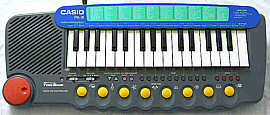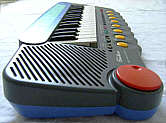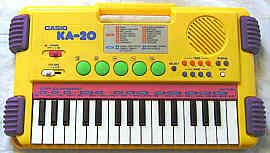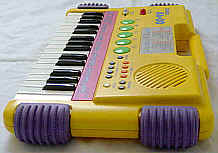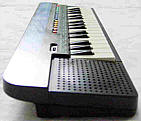CASIO
PA-31,
Casio
KA-20,
Casio
SA-8,
Casio
SA-2,
Casio
TA-10 |
small
keyboards with complex lo-fi wavetable sounds |
|
These keyboards all belong to the Casio SA-21 hardware class,
which was the direct successor of the Casio
SA-1 hardware. Sound engine and behaviour are basically identical;
the only difference is that the newer CPU supports 5 different demos (through
5 OBS buttons) and 5 drumpads. Due to the similarity I only describe here
the differences to the SA-1 hardware (see there).
Casio PA-31

Unlike Casio SA-1, this
instrument is 4 note polyphonic, plays samples with higher bit resolution
and has 4 demo melodies. Unfortunately the digital volume control is gone,
which on the SA-1 could be used as a sound effect to change the sample
bit resolution and the speed of algorithmic preset sounds (e.g. mandolin
ring).
The special feature of the Casio PA-31 in comparison to other such
keyboards is the so-called "voice pad controller", which is simply a set
of 8 sound effect buttons those play each a fixed low resolution sample
(like drumpads), which pitch can be adjusted with a knob within a bit more
than 1 octave.
different main features:
-
32 midsize keys
-
built-in speaker (ca. 8cm, less harsh)
-
main voice polyphony 4 notes (only 3 with accompaniment)
-
volume slide switch (5 steps) instead of digital volume control
-
8 OBS effect sample pads {"hello!", slap bass(?), heavy metal guitar, dog,
cat, "dah!"- voice (child), "deh!"- chorus, "hi!"} with pitch knob (>1
octave)
-
higher sample resolution(?) than Casio SA-1
-
main CPU "OKI M6387-11, 253523" (30 narrow pin DIL)
-
effect sound CPU "OKI M6373-349, 2232351" (18 pin DIL)
-
4 demo melodies (complex orchestrated)
-
Choral (Beethoven) [= "Ode to Joy"]
-
Twinkle Twinkle Little Star [missing the main voice?]
-
Nocturne (Chopin)
-
Jingle Bells
eastereggs:
-
5 drumpads addable (those exist in Casio KA-20 and SA-21)
notes:
All sounds of this instrument sound cleaner and less harsh than with Casio
SA-1. I am not sure if the output DAC bit resolution is increased
by external discrete components (demultiplexer?) or if it is just better
filtered.
The "voice pad controller" is implemented by the independent CPU "OKI
M6373-349", which clock speed can be adjusted with the big red knob to
change the pitch. Unfortunately the effect pads respond too slow for fast
trilled sounds and have only a monophonic sound generator. The low- res
effect samples sound quite noisy but not harsh. (I haven't examined the
hardware yet.)
The demos are nice and complex orchestrated although they are quite
short (repeating in a loop) and the tune "Twinkle Twinkle Little Star"
sounds almost like when the programmer forgot to add the main voice because
most of the time plays only the accompaniment and 2nd voice (obligato?);
the melody voice appears only for a few seconds as ringing mandolin. On
the Casio SA-35
this tune indeed exists complete with main voice and there the main voice
can be muted by hand to train playing.
Casio KA-20

This quite rare yellow toy keyboard was apparently the model for the
widely spread and greatly bizarre sounding My
Music Center, because it has many design elements and even some
sounds common with it.
Both have a case with moulded handle opening at the top, 32 keys, 5 drumpad
buttons and 4 edge protectors, although My Music Center is typically
red with yellow plastic protectors while the violet protectors on KA-20
are of rubber. The percussion timbres of
My Music Center sound even
like low- res samples of the latter, both include a honky- tonk piano sound
and multiple demo tunes, and also the arrangement of the wonderful "Jingle
Bells" demo has noticeable similarities with the
Casio model (regard
the trilled notes) although they are not identical. The My Music Center
is also much smaller and has mini keys while
KA-20 has a midsize
keyboard. An even closer case imitation of it was the Sun
Ta Toys SDN BHD 1996, although its "Jingle Bells" is arranged differently.
Unlike the tinny My Music Center, the sounds of Casio KA-20
are astonishingly clear and even the speaker sounds pleasantly warm and
has some bass. The KA-20 uses the same CPU like the Casio
PA-31, but has only 16 sounds due to omitted cipher buttons. These
are the differences to the PA-31:
different main features:
-
built-in speaker (sounds astonishingly warm and clear)
-
only 16 preset sounds {piano, honky- tonk piano, pipe organ, church organ,
samba whistle, quena, bagpipe, harmonica, glass harmonica, waw voice, cosmic
dance, plunk extend, airplane, insect, telephone, car horn}
-
only 4 cipher buttons
-
5 drumpad buttons {base, snare, hihat, agogo (?, resembling cowbell), cymbal}
-
no "voice pad controller"
-
no jacks
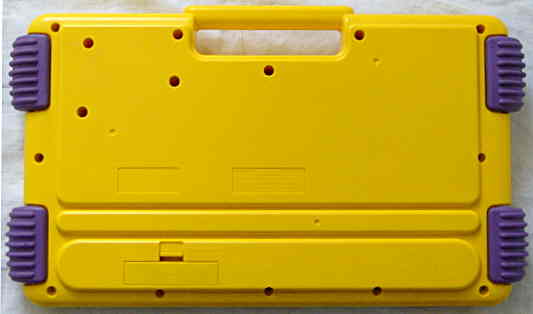
eastereggs:
-
6 additional cipher buttons addable (to select all 100 preset sounds)
notes:
The only 4 available cipher buttons {"1", "2", "3", "4"} of the Casio
KA-20 correspond to the buttons {"0", "2", "6", "7} on the SA-1
(or
PA-31).
It is very recommended to add also the 6 missing buttons to get access
to the 84 missing preset sounds buried in its CPU. (I didn't modify mine
because I already own the PA-31. I haven't examined the hardware yet.)
A red, Japanese language keyboard with same case and ROM-Pack
slot instead of the preset sound list, key lighting (LED row) and 8 OBS
preset sounds(?) was released as Casio - Sound Kids 02 (alias Casio
KS-02, I got the box photo from a collector).
Casio SA-8
Also this 2 note polyphonic instrument is based on the same CPU, thus I
only will describe here the differences to the latter. Someone told me
it was also released as Casio SA-3 and a green/ purple version as
Casio
SA-9.
different main features:
-
only 25 preset sounds {piano, elec piano, honky- tonk piano, harpsichord,
pipe organ, brass ens, warm brass, trumpet, tuba, english horn, samba whistle,
whistle, quena, flute, bagpipe, strings, warm strings, violin, violin-
piano, elec guitar, glass harmonica, fantasy, waw voice, twinkle echo,
cosmic dance}
-
only 5 cipher buttons
-
4 drumpad buttons {hihat, base, snare, cymbal}
-
CPU "OKI M6387-11, 183536" (30 narrow pin DIL)
-
only 2 demo melodies (complex orchestrated)
-
Jingle Bells
-
Choral (Beethoven)
-
no sound output jack

eastereggs:
-
likely all main sound features of the Casio PA-31
(except "voice pad controller"), 5 drumpads and 3 additional demo button
addable
notes:
This thing resembles basically my Casio PA-31 but is 2 note polyphonic
and has only 25 sounds - apparently due to omitted cipher buttons. I guess
it was the cheaper version of the
Casio SA-6 (black, roughly oval
mini keyboard) which has 100 preset sounds, 5 drumpads and 5 demos.
The only 5 available cipher buttons {"1", "2", "3", "4", "5"} of the
Casio
SA-8 correspond to the buttons {"0", "1", "2", "3", "6"} on the Casio
SA-1. It is very recommended to add also the 5 missing buttons
to get access to the 75 missing preset sounds buried in its CPU. Technically
it is likely possible to upgrade the SA-8 with 4 note polyphony
and all the other features found in the Casio SA-21 or also PA-31
(except
"voice pad controller") because both contain the same CPU. But for this
a diode would need to be soldered into the line of each key, and also the
CPU needs to be switched into SA-21 mode (likely by a permanent diode somewhere
in the keyboard matrix). The PA-31 contains also additional descrete
components (capacitors and resistors); I haven't examined if these have
to do with the keyboard matrix or if they only improve the sample resolution.
(I haven't examined the hardware yet because I own already the SA-1
and PA-31.)
Casio SA-2
This lousy little tablehooter from 1995 (embossed case date stamp) is an
even more crippled version of the Casio SA-8.
It has no(!) tempo control, only 2 volume steps, only 16 preset sounds
(due to 4 cipher buttons) and no drumpads anymore. A red version of it
was released in 1995 as Casio KA-2.

Don't confuse the SA-2 with the similar looking Casio
SA-5, which is way more versatile and has fantastic tekkno synth
sounds.)
different main features:
only 16 preset sounds {piano, elec piano, honky- tonk piano, harpsichord,
brass ens, warm brass, trumpet, tuba, samba whistle, whistle, quena, flute,
strings, warm strings, violin, violin- piano}
only 4 cipher buttons
no tempo control
only 2 step volume slider
no drumpad buttons
CPU "OKI M6387-11, 5092301" (30 narrow pin DIL)
only 1 demo melody: "Choral (Beethoven)" [="Ode to Joy"]
no sound output jack

eastereggs:
-
everything of the above instruments
Very annoying is that this horrible crippled tablehooter has only a mechanical
switch for 2 volume steps despite its CPU would support digital volume
control. Also the omitted tempo buttons are inexcusable. The SA-2
is certainly good for circuit bending (all the missing stuff can be added
by matrix eastereggs), but for not much else. (I would never have bought
one of these but found mine in a junk pile after a flea market.)
Casio TA-10
This is basically a midsize Casio SA-8
with built-in stereo cassette player. This is not a cassette recorder despite
there is a microphone for singing, and despite midsize keys it is only
2 note polyphonic. Due to extreme similarity I only describe here the differences
to the SA-8.
different main features:
-
32 midsize keys
-
2 speakers (10cm, keyboard is mono, cassette plays stereo)
-
analogue volume slider (instead of +/- buttons)
-
only 3 drumpad buttons {hihat, agogo, base}
-
only 1 demo button ("Twinkle Twinkle Little Star")
-
built-in stereo cassette player (no recorder)
-
jacks for AC-adapter & microphone
notes:
This keyboard came with the German audio cassette "Mein Casio TA-10
Keyboard - probieren, spielen, lernen". With my specimen the cassette
sounds detuned against the keyboard and plays a little higher; likely the
cheap plastic tape drive runs a bit too fast. The first cassette side musically
explains the functions of the keyboard. Then the player shall accompany
an imaginary eerie movie scene with the "fantasy" sound. On side
2 there are 6 German children songs. First it plays a complete version,
then followed by only the accompaniment to play to.
The 6 children songs are:
-
Alle meine Entchen (="All My Ducks")
-
Hänschen Klein (="Little Bee")
-
Es tanzt ein Bi-Ba-Butzemann
-
Meister Jakob (="Brother John")
-
Vogelhochzeit
-
Guten Abend, Gute Nacht (= Brahms lullaby)
The songs are nice polyphonic arrangements and were likely played on one
of the professional Casio workstation keyboards with its automatic accompaniment.
Instruments of this hardware class also include the midsize keyboards
Casio
SA-21/
SA-38/
SA-39 (all same case, 5 drumpads, 2 speakers,
100 sounds) and the oval mini keyboard
Casio SA-6 (100 sounds, 5
drumpads).
| removal
of these screws voids warranty... |
|
|
 |

|
|
| |
back
|
|
